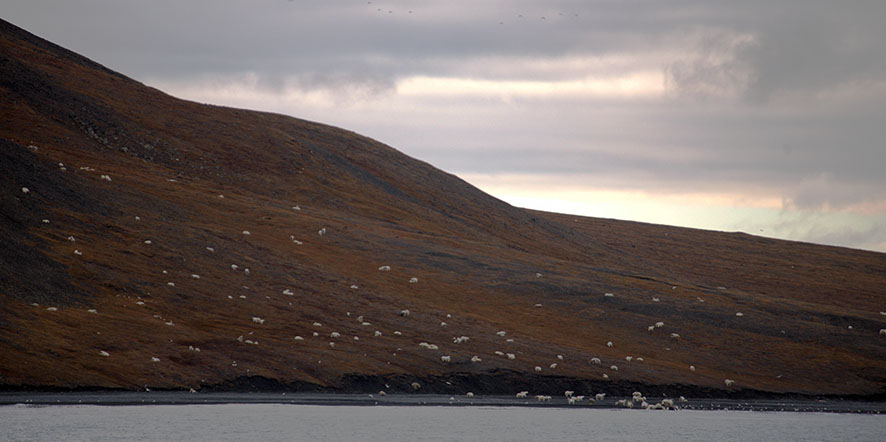Picnic Time! 230 Polar Bears Feast on Whale Carcass

Hundreds of hungry polar bears were treated to a whale of a buffet last week when the carnivores descended on a whale carcass on the coast of Russia's Wrangel Island.
The incredible sight was photographed by tourists on a boating expedition that was traveling through the Northeast Passage.
"We were cruising down the coast and saw a 'herd' or 'convention' of polar bears on/near the beach," on Sept. 19, Rodney Russ, the expedition leader, wrote on his blog. Russ is the owner and founder of Heritage Expeditions, the New Zealand-based company that co-led the trip. [In Images: Polar Bears on Google Street View]
Russ immediately realized why the polar bears (Ursus maritimus) "of all ages, sexes and sizes" had congregated there: They were feasting on a dead bowhead whale (Balaena mysticetus), he wrote in the blog post. Russ counted more than 150 polar bears, although a statement issued by the Wrangel Island State Nature Reserve put that estimate at closer to 230 bears.
Intrigued, the tour group left their boat, the Akademik Shokalskiy (the same vessel that got stuck in Antarctic sea ice in December 2013) and boarded smaller vessels known as zodiacs to get a closer look at the seemingly ravenous bears.
"That is the memory we will all carry with us," Russ wrote. "There are no words to describe it."
It's possible so many bears attended the impromptu picnic because they smelled the rotting whale. Polar bears can smell seals up to 20 miles (32 kilometers) away, according to the San Diego Zoo. When they're not eating beached whales, the bears are known to eat ringed seals, walrus, caribou, grass and seaweed, the San Diego Zoo says.
Get the world’s most fascinating discoveries delivered straight to your inbox.
Polar bears are listed as vulnerable to extinction, largely because human-made climate change is melting the Arctic sea ice where they live, according to the International Union for Conservation of Nature (IUCN).
It's unclear, however, whether climate change had made these particular bears hungrier than usual. The frequency of starving polar bears is expected to increase as the climate warms and sea ice declines — not just because of climate change directly, but because ice loss is taking away seals, their main food source, Steven Amstrup, chief scientist at Polar Bears International, a nonprofit research organization dedicated to studying polar bears, told Live Science in 2015.
The bowhead whale is listed as an "animal of least concern," meaning it is not at risk, the IUCN says.
This isn't the only bear-on-whale banquet in the books. In June 2016, a naturalist guide for a lodge in Alaska spotted a brown bear snacking on a sperm-whale carcass in the southeastern part of the state.
If you want to glimpse a polar bear on your own, watch the polar bear cam at the San Diego Zoo — just know these bears won't be eating any whales.
Original article on Live Science.

Laura is the managing editor at Live Science. She also runs the archaeology section and the Life's Little Mysteries series. Her work has appeared in The New York Times, Scholastic, Popular Science and Spectrum, a site on autism research. She has won multiple awards from the Society of Professional Journalists and the Washington Newspaper Publishers Association for her reporting at a weekly newspaper near Seattle. Laura holds a bachelor's degree in English literature and psychology from Washington University in St. Louis and a master's degree in science writing from NYU.



